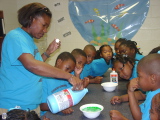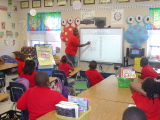-
Category 2
Selected in 2012
-
Grades: pre k - 5
School Setting: urban
Town Population: 200,000
Student Enrollment: 600
Student Demographics:
Black/African American: 96%
Teacher/Student Ratio: 1:23
White/Caucasian: 2%
Hispanic: 2%
Hawaiian/Pacific Islander: 0%
Asian: 0%
Native American: 0%
Other: 0%
% Reduced Lunch: 98%
% ELL Learners: 2%
Founded: 1948 -
PRINCIPAL:
Dianne Reynolds -
CONTACT:
3071 Ralston Road
Mobile, AL 36606
251-221-1705
cythensislang@mcpss.com
Spencer-West Lawn Elementary School
Mobile, AL
The fact is, if students are not learning, we cannot say that we have met our responsibilities. We believe this in spite of socio-economic backgrounds, gender, race, home environment, etc. We accept that this is difficult work that puts a tremendous amount of responsibility on the teacher, but members of our school are an elite class who are up to the challenge. We embrace challenges and they seem to bring out the best in us.
- Describe the most successful activity your school has initiated to strengthen the ties to your community.
- This question proves difficult to answer because a combination of activities has brought about a better home-school connection. These include parenting activities such as technology sessions, Literacy Nights, curriculum presentations, partnership conferences, etc. However, the activity that has received the greatest community response would be student performances. Each grade level showcase their talents by performing twice per year at various events. Data presentations are a part of those events at least four times a year. High stakes assessments and End of Quarter Tests are shared using themes, music, and animations. It has become a favorite part of the school experience. The energy during the presentations rivals that of a major sporting event. Students and parents proudly cheer as their class performance is displayed on screen. Because we take ownership of our data, it is displayed throughout the school. We believe in total transparency; therefore, parents know how each class performs rather than just the school or grade level.
- What is the single most important factor in the success of your school that others could replicate?
- The single most important factor that contributed to our success would be the selection and retention of a highly qualified and committed staff who have a heart for children. Although this answer may sound somewhat prosaic, it is nonetheless true. It has been my experience that no amount of resources, programs, etc. can compensate for educators who are willing to invest in every student’s achievement. Time and effort must be allocated to ensure that each teacher has the appropriate professional development, but more importantly, buy-in. The principal is the lead person in this process by initiating one-on-one conversations of expectations, support, and individual improvement plans for those who are not successful. The fact is, if students are not learning, we cannot say that we have met our responsibilities. We believe this in spite of socio-economic backgrounds, gender, race, home environment, etc. We accept that this is difficult work that puts a tremendous amount of responsibility on the teacher, but members of our school are an elite class who are up to the challenge. We embrace challenges and they seem to bring out the best in us. The key word in our school is “ownership”. We take ownership of what our students learn, good or bad. In 2003-2004, our school was one of the lowest performing schools in the State of Alabama and had been slated for State takeover if improvements were not made. With an effective school improvement plan that attacked every aspect of the school program from academics to discipline and a fearless team who was willing to execute it, we began to be successful by the end of 2004. However, it took years of recruiting a staff who had the “right stuff” for us to begin to excel. By 2010, we were identified by the State of Alabama Department of Education as a Torchbearer School which are high poverty, high performing schools. We won this honor again in 2011. In 2012, we were named a National Blue Ribbon School by the U.S. Department of Education. This could not be accomplished without a staff who believes that student achievement is non-negotiable. Without a committed educator, programs and initiatives are like a shiny new car with no motor or driving force. Currently we are in the process of enhancing technology in our school, but we have no doubt that if we did not have a computer, Smart Board, iPad, etc. we would still be successful because our pride is in the people, not programs.
- Describe the program or initiative that has had the greatest positive effect on student achievement.
- Spencer-Westlawn was part of several State of Alabama Initiatives, the Alabama Reading Initiative (ARI) and the Alabama Reading First Initiative (ARFI). Each initiative provided an intense concentration on effective reading instruction as espoused by the National Reading Panel. The five core components of reading were implemented which included comprehension, vocabulary, fluency, phonics, and phonemic awareness. DIBELS (Dynamic Indicators of Basic Early Literacy Skills) which focused on fluency was also part of our school’s reading program. Consultants delivered systematic professional development. Reading coaches were provided to assist teachers with side-by-side coaching, as well as other professional development. Teachers learned to deliver a balanced approach to reading, instead of the arbitrary methods to which they had become accustomed. The Open Court Reading Program was used to great success, as well as the Reading Street textbook series. Regardless of the program, the goal was to teach to fidelity in order to maximize student learning. A common thread with all initiatives and programs was explicit direct instruction and differentiated instruction because one size does not fit all.
- Identify the professional development activities you use to improve the teaching portion of the teaching and learning process.
- Our school has engaged In a multitude of professional development activities. Each year we identify school-wide focuses in which we feel that all our students could benefit. There is a lot of job-embedded professional development at our school, as well as that which the District provides. Examples of job-embedded professional development include technology, data analysis, differentiated instruction, book studies, explicit direct instruction, the cycle of instruction, PD360 on various topics, diversity, etc. Several methods are used in scheduling professional development such as quarterly half day sessions on technology that is delivered by the University of South Alabama Technology Department and those that have replaced the old after school faculty meetings such as book studies. Each grade level and specialty area teachers are scheduled throughout the year to lead book studies. The delivery format must include the cycle of instruction, technology, and interactive activities for participants. This has been most successful because teachers are learning from each other. Also, presentations usually result in additional research that enhances teachers’ skills. The PD360 online professional development program has also been utilized to enhance instruction. A professional development calendar helps to organize all activities and ensures that we are addressing all needs of the school program.
- Describe how data is used to improve student achievement and inform decision making.
- Our school holds weekly data meetings to analyze data from a variety of assessments which include End of Quarter Tests, common assessments, DIBELS, STAR. AR, etc. Each data meeting begins by teachers calculating the proficiency rate (a minimum of 77% required) for the class in reading, math and science. Then the grade level calculates the proficiency rate (a minimum of 77% required) for the grade level. Instructional gaps are identified and strategies for improvement are developed and documented. Students’ progress is monitored weekly. This process eliminates the guess work out of student performance and helps to prepare students for high stakes assessments. The principal facilitates data meetings, but teachers play the most essential role in determining how they will ensure the success of their students.
Stats
-
Category 2
Selected in 2012
-
Grades: pre k - 5
School Setting: urban
Town Population: 200,000
Student Enrollment: 600
Student Demographics:
Black/African American: 96%
Teacher/Student Ratio: 1:23
White/Caucasian: 2%
Hispanic: 2%
Hawaiian/Pacific Islander: 0%
Asian: 0%
Native American: 0%
Other: 0%
% Reduced Lunch: 98%
% ELL Learners: 2%
Founded: 1948 -
PRINCIPAL:
Dianne Reynolds -
CONTACT:
3071 Ralston Road
Mobile, AL 36606
251-221-1705
cythensislang@mcpss.com









